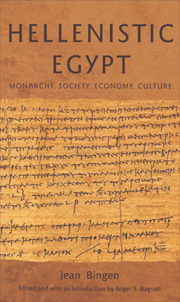Book contents
- Frontmatter
- Contents
- Original Sources of Chapters
- List of illustrations
- Glossary
- Maps
- Foreword
- Introduction: Jean Bingen and the currents of Ptolemaic history
- Part I The Monarchy
- 1 Ptolemy I and the quest for legitimacy
- 2 Ptolemy III and Philae: snapshot of a reign, a temple, and a cult
- 3 Cleopatra, the diadem and the image
- 4 Cleopatra VII Philopatris
- 5 The dynastic politics of Cleopatra VII
- Part II The Greeks
- Part III The Royal Economy
- Part IV Greeks and Egyptians
- Conclusion
- Bibliography
- General index
- Index of passages discussed
- HELLENISTIC CULTURE AND SOCIETY
4 - Cleopatra VII Philopatris
from Part I - The Monarchy
- Frontmatter
- Contents
- Original Sources of Chapters
- List of illustrations
- Glossary
- Maps
- Foreword
- Introduction: Jean Bingen and the currents of Ptolemaic history
- Part I The Monarchy
- 1 Ptolemy I and the quest for legitimacy
- 2 Ptolemy III and Philae: snapshot of a reign, a temple, and a cult
- 3 Cleopatra, the diadem and the image
- 4 Cleopatra VII Philopatris
- 5 The dynastic politics of Cleopatra VII
- Part II The Greeks
- Part III The Royal Economy
- Part IV Greeks and Egyptians
- Conclusion
- Bibliography
- General index
- Index of passages discussed
- HELLENISTIC CULTURE AND SOCIETY
Summary
During the year 37/36 bc, regnal ‘year 16’ of Cleopatra VII and Ptolemy XV Caesar was officially renamed ‘year 16 which is also year 1’. The double dating that was introduced at that moment was to be used until 30 bc, with ‘year 22 which is also year 7’ marking the tragic end of both the double reign and the Ptolemaic era. The consensus is now well established, I believe, that the introduction of this double dating is more or less directly connected with what are generally called the first territorial concessions of Mark Antony to Cleopatra, an explanation which is confirmed by Porphyry's Chronicle. Michel Chauveau showed that it is necessary to look for the origin of such a double dating – surely a royal initiative – not in the adoption of a coregent, but in a political reorientation considered important enough to mention in a second starting-point for the count of the regnal years. More precisely, I believe that such a move was initiated by a change in the Alexandrian royal ideology, and not by the concomitant territorial extensions. The latter are more a consequence of the new policy which Cleopatra VII planned to carry out with the help of Antony.
- Type
- Chapter
- Information
- Hellenistic EgyptMonarchy, Society, Economy, Culture, pp. 57 - 62Publisher: Edinburgh University PressPrint publication year: 2007

